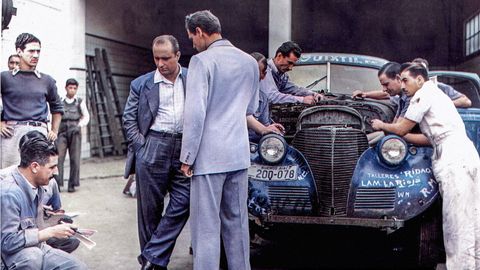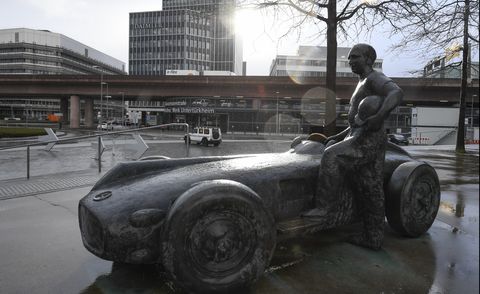
Keystone-FranceGetty Images
- A Life of Speed: The Juan Manuel Fangio Story is a new Netflix documentary that traces his path to becoming arguably the best driver in Formula 1 history.
- Fangio won five world championships with four different manufacturers—including Maserati and Mercedes-Benz—between 1951 and 1957.
- The documentary chronicles his racing career through a mix of archival footage, past and present interviews, and some re-enacted scenes.
Juan Manuel Fangio is arguably the best racing driver Formula 1 has ever known, with one of the highest winning percentages in the sport’s history. He also happens to be the most famous driver whose story most people under 50 don’t know. Now, the late Argentinian—the man whom F1 legends including Ayrton Senna and Sir Jackie Stewart have called the greatest driver of all time—is getting more of the mainstream exposure he deserves thanks to a new documentary on Netflix called A Life of Speed: The Juan Manuel Fangio Story.
We just watched the film, which has a running time of one hour and 32 minutes, and enjoyed its enlightening albeit straightforward method of telling Fangio’s story. Along with a small mix of reenactments that feature what are presumably his old race cars (or at least replicas), it primarily chronicles his career through archival footage as well as past and present interviews.
While the documentary obviously focuses on the Juan Manuel Fangio story—title drop—there’s also plenty for racing fans to learn about the formative years of Formula 1, which held its inaugural season in 1950. That year, Fangio was a rookie driver for Alfa Romeo along with teammates Giuseppe “Nino” Farina and Luigi Fagioli. Together they were known as the Three Fs. Fangio didn’t win the championship his first year, but he finished second overall in points.
He then went on to win it all the following season, before getting in a serious crash at the Monza circuit in 1952. That near-fatal accident was only the second of his career, Fangio recalls, in an interview that’s included in the documentary. His first was in 1948, at the Grand Prix of South America, when he took a corner too fast and ended up killing his friend and co-driver. Five years later, after not being able to finish the ’52 season due to his crash in Italy, Fangio returned to F1 and finished second in points.
That impressive return spurred his legendary run of four straight championships driving for four manufacturers: Maserati and Mercedes-Benz (1954), Mercedes (1955), Ferrari (1956), and finally Maserati again in 1957. Fangio decided to retire the next season amid problems with his race car, the sport becoming more commercial, and even getting kidnapped(!) in Cuba. He says he started thinking about all of it while in the middle of a race and decided right then and there that he was going to retire after it was finished. And that’s exactly what he did.
The achievements in his racing career continue to be impressive to this day. The documentary states that in 51 races he won 24 victories, 35 podiums, 29 poles, and 23 fast laps. His legacy even led the University of Sheffield to conduct a 2016 study to scientifically determine that Fangio was the best F1 driver in history.
How do you study that? The documentary explained that the study analyzed driver talent versus the quality of the car the driver was in. For example, Michael Schumacher has the most wins in the history of the sport, but he’s ranked number nine. The study also concluded that the race team matters about six times more than the driver when it comes to success in Formula 1. The fact that Fangio was able to consistently perform at the highest level while driving for four different manufacturers over his career is truly remarkable and something the sport will likely never see again.
“I wasn’t an extraordinary driver. I worked within my means and calculated my rival’s strength,” Fangio once said. It’s true. He was physically, emotionally, and mechanically prepared for every race. He also knew how to make the most out of himself and the car. A Life of Speed reminds us of how dangerous and demanding F1 was during its infancy, but, more importantly, it’s a reminder of just how truly talented and transcendent Juan Manuel Fangio was.
Source: Motor - aranddriver.com








